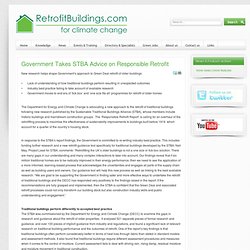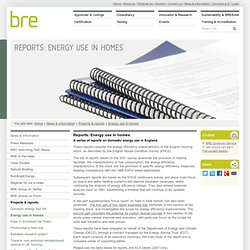

‘Fabric first’: The best approach when building to high levels of the CfSH. ‘Fabric first’: The best approach when building to high levels of the CfSH Posted by guest author on Wed, Feb 01, 2012 Jenny Smith Andrews at H+H, offers her views on why getting a home’s envelope built as airtight and thermally efficient as possible is the best foundation for building to high levels of the CfSH.

Using the correct methods, we believe it is more than possible to build cost effectively to level 4 of the Code for Sustainable Homes (CfSH) with minimal or even no use of renewable technologies. We also believe that this can be done without entirely rethinking the way houses are designed and built. Only small tweaks are required in fact, not the radical departures that some advocate. Putting as much effort as possible into the fabric of a home makes sense in many ways. Compare that with how complicated some renewable technologies are, especially their control interfaces. Such technologies also advance at frightening pace. A natural materials fabric first approach to retrofit - by fran bra...
Institute for Sustainability - institute for sustainability, sustainability, charity, demonstration, research, knowledge, sustainable, institute of sustainability, smart city, innovation, cities, communities, the institute for sustainability, ifs, communi. Parity Projects - Experts in low energy refurbishment - Parity Projects - Home Energy Masterplan. The European portal for energy efficiency in buildings. As for the floor, the high insulation standard could be reached by using vacuum insulation although the floor height was limited.

The thermal bridges of the existing rising brickwalls were compensated by a circumferential umbrella-shaped insulation. With this, the heating energy requirement of 27,100 kWh/a of liquid gas were reduced to only 3,170 kWh/a power generated from solar energy, even though the useful floor space was doubled from 97 m² to 217 m²! Building Research & Information - Volume 38. Category: Retrofit. Archive for the ‘Retrofit’ Category Daylight can help us to live more healthily By Cora Kwiatkowski, Senior Associate for Stride Treglown Architects are continuously on the look-out for the better insulation, the paint with no solvents, the more sustainable timber systems, and the new state of the art material.

But natural light? We don’t give it the special attention it deserves, although it is a very special building material, is readily available, not owned by individuals or countries - and it is free. In 1903 Professor Niels Finsen discovered that direct sunlight can heal tuberculosis. By the early 1990s, a drop in Housing Association space and quality standards in England began to be identified by a number of research reports. Numerous recent studies have shown that daylight increases our concentration and efficiency, reduces depression, improves our mood and general well-being and decreases stress and illnesses. Will daylight standards form part of our future housing standards? The risks and rewards of eco-refurbishment. Lucy Pedler.

Director: The Green Register Since June 2010 we’ve been running our ‘Eco-refurbishment and The Green Deal’ seminar where ‘warts and all’ presentations of residential case studies give delegates in-depth information on how to retrofit their buildings in a sustainable, low carbon way. But one of the frequently asked questions raised in these seminars is ‘what are the risks of interstitial condensation when applying insulation to an existing building?’ As the economy plummets but fuel prices sore, construction professionals are increasingly working on upgrading their clients’ properties rather than new build projects but are very concerned that by adding roof, wall and floor insulation this will move the dewpoint and cause moisture to build up within the fabric of the external envelope.
PRACTICE: DEAL OR NO DEAL? Hot on the heels of the Green Deal comes a strong note of caution in the form of the Responsible Retrofit of Traditional Buildings report from the Sustainable Traditional Buildings Alliance (STBA) on behalf of the Department of Energy and Climate Change (DECC).

The report that I authored with Neil May highlights both the lack of an existing evidence base for decision-making on retrofit of traditional buildings (pre-1919); and risks surrounding roll out of the Green Deal and other retrofit packages if applied generically to traditional building stock. It emphasises that traditional buildings perform differently to modern buildings, both pre or post retrofit, and should not be treated with a one-size-fits-all approach. Government Takes STBA Advice on Responsible Retrofit. New research helps shape Government’s approach to Green Deal retrofit of older buildings • Lack of understanding of how traditional buildings perform resulting in unexpected outcomes• Industry best practice failing to take account of available research• Government moves to end era of ‘tick box’ and ‘one size fits all’ programmes for retrofit of older homes.

The Future for Architects? - Building Futures. New study into the future of practice In this study Building Futures sets out to explore the future role of architects, asking: who will design our buildings in 2025; what roles will those trained in architecture be doing then and how will architectural practice have changed as a result?

Through a series of one-to-one interviews and round table sessions the study aims to examine the breadth of those who shape the built environment: including traditional architects and those working in expanded fields of practice, as well as clients, consultants and contractors. The resulting speculations should be an opportunity for discussion and interrogation- an exploration of the imminent changes likely to affect the industry over the next 15 years. Watch this space for information about future events related to ‘The Future for Architects?’. New! Reports: Energy use in homes. A series of reports on domestic energy use in England These reports consider the energy efficiency characteristics of the English housing stock, as described by the English House Condition Survey (EHCS).

The set of reports based on the 2001 survey examines the provision of heating facilities, the characteristics of fuel consumption, the energy efficiency characteristics of the stock and the provision of specific energy efficiency measures, drawing comparisons with the 1996 EHCS where appropriate. Subsequent reports are based on the EHCS continuous survey and place more focus on space and water heating systems and thermal insulation measures, whilst continuing the analysis of energy efficiency ratings.
They also extend temporal analysis back to 1991, establishing a timeline that will continue to be updated annually. A two part supplementary 'focus report' on 'hard to treat homes' has also been produced. Please see the table below for reports and XLS tables (2007 only). Additional reports: Project: Sitting rooms to cities: refurbishing the existing stock. The BRE Trust has commissioned this research to establish the socio-economic and environmental benefits of large scale domestic refurbishment projects to the local community in the area.

The aim of this research is to identify mechanisms which can contribute to a localised “ripple” effect and increase uptake of energy efficient refurbishment projects in the area. Output. Victorian buildings reborn. A pioneering partnership to transform Victorian buildings into energy efficient accommodation for the 21st century was launched at BRE in June 2006 by HRH The Prince of Wales, President of The Prince's Foundation for the Built Environment.

The collaboration between The Prince's Foundation, BRE, the East of England Development Agency and the University of Hertfordshire is initially focusing on the refurbishment of a Victorian stable block on the BRE site. The project will demonstrate and analyse how older buildings with solid walls, poor insulation, draughty windows, inadequate heating and in a state of general disrepair can be transformed to provide attractive, flexible and energy efficient accommodation for the future. The National Refurbishment Centre.
Green refurbishment: gathering evidence for a nationwide delivery The National Refurbishment Centre is a joint venture between the BRE Trust and the Energy Saving Trust, with partners from across the sector. Its aim is to provide evidence and knowledge that support a step-change in the delivery of green refurbishment and retrofit on a nationwide scale. With energy bills rising and the UK committed to reducing overall CO2 emissions by 80% by 2050, it is critical that our existing buildings - among the oldest in Europe - are made more energy-efficient. Nevertheless, understanding how to deliver a national sustainable refurbishment programme remains elusive. An evidence hub. National Refurbishment Centre: Integer House House Blog. National Refurbishment Centre: Reducing carbon emissions and tackling fuel poverty.
National Refurbishment Centre. Project: Towards zero (T-zero) emission refurbishment options in UK housing. The T-zero project website is now live and looking for suppliers and case studies. Please visit the T-Zero website. There is now a wide governmental and scientific consensus on the need to shift to a low-carbon economy. The UK has set itself the target of a 60% reduction in CO2 emissions by 2050. Nearly one third of UK carbon emissions are from housing. We can and should build new houses to rigorous energy efficiency standards. T-Zero. What is T-ZERO? T-ZERO is a project initiated by some of the UK’s leading organisations in the fields of energy conservation and housing (see right). It is supported by the Technology Strategy Board with a brief to develop novel ways to reduce the environmental impact from existing housing, working towards a future goal of a zero carbon built environment.T-ZERO provides an interactive web-based tool that puts energy and environmental performance expertise in the hands of the householder, housing stock manager, designer or builder.
Why T-ZERO? The UK is committed to an 80% reduction in carbon emissions by 2050 and this will require reductions from the domestic sector that potentially exceed this, as additional reductions here will be required to offset higher emissions in sectors such as aviation and road transport. Restoration Home - Big House - Episode Six. Environmental Change Institute (ECI) - Oxford University. Read more about this project on the 40% House website. The Royal Commission on Environmental Pollution reported that the UK needs to achieve a 60% reduction in CO2 emissions by 2050 if we are to contribute to an avoidance of significant climate change.